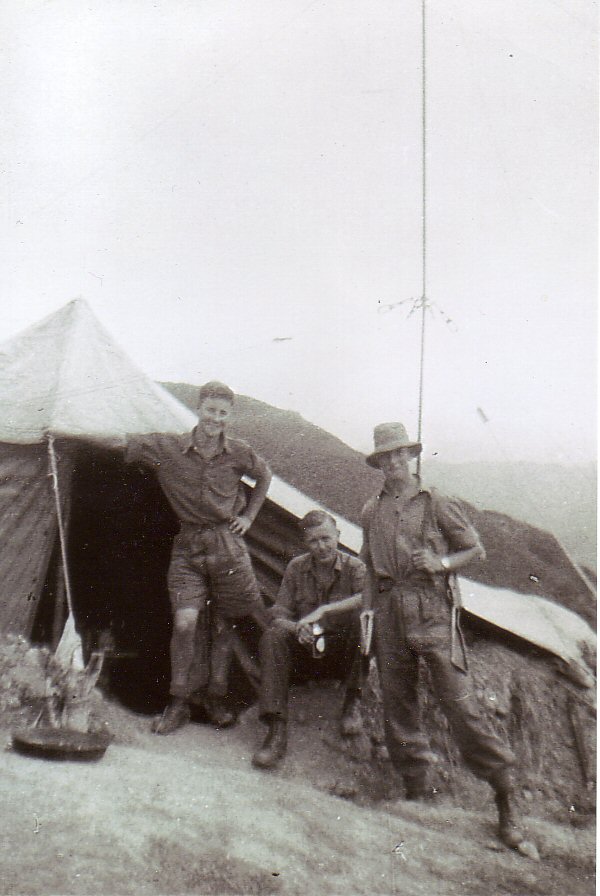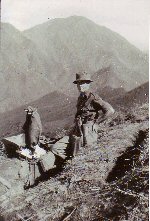|
| ||
 |
Good Times for a Gunner
Jim Ross Hong Kong 1949, Malaya 1950-1951 |

|
|
Early in 1949, a small party of subalterns left Auckland for attachment to Far East Land Forces of the British Army. We had all graduated from the RMC, Duntroon, known to its denizens as 'the Clink', in December '47 after a three year course and then spent most of '48 in 2NZEF Japan. This new posting was designed to correct "wrong impressions" gained in J Force. Included were Graham Boswell, Armoured, who went initially to the Royal Tank Regiment, Hong Kong, and J Ross and Ted Tomline, RNZA, also at first to that Colony, and we were to hoist in the "right attitudes" for eighteen months, a period which turned out to contain constant interest and excitement. Hong Kong I was allotted to 25 Fd Regt, RA, living under canvas beside the Fan Ling Golf Course, while Ted Tomline went to 14 Fd Regt. Forces in Hong Kong had been rapidly built up to the whole 40th Infantry Division plus, as the Communists were driving Chiang Kai Shek's troops south towards the Colony. It was anticipated that Ho Chi Minh's lads might well sweep in over our boundary, therefore we trained, waited, and kept watch. My battery, 35 Fd Bty, maintained a permanently manned OP (observation post) on Robin's Nest, a 490 metre feature, overlooking the frontier on the river valley below, approximately 1000 yds away. A platoon of 2/6 Gurkha Rifles, the battalion we supported, lived around our OP party. 25 Fd Regt was on the lower establishment - 3 guns per troop - and below strength. It had taken part in the Burma Campaign, and the transport was in very poor shape. Someone watched our road movement, commenting on the amazing uniformity of vehicle interval, but noted that this was the result of half the trucks being under tow, and of course all issue tow ropes were the same length. | ||
|
I was just about to finish my week in the OP when the Kuomintang infantry started moving west along our frontier in retreat. They moved along the bunds between the padi fields in sections of 7 to 8 men, each followed by 2 women in dark clothes carrying heavy loads on shoulder yokes, and 2 or 3 women in bright colours with no visible loads. Our signal to this effect brought an electric response, as the arrival of the Communists had not been expected so soon, therefore the division occupied defensive positions, the div arty deployed, and Boswell's troop of Comet tanks got "bombed up", as they termed it. By the following morning, Communist troops had occupied the area across the frontier river and they had placed a sentry on the bridge across it, but it became obvious that they had no intention of invading the Colony. Life in the OP was quite interesting, observing the Communist activities through our beautiful "telescopes stereoscopic", a sort of double-barrelled periscope, known as the "donkey's ears". | ||
|
As the threat lessened, the Royal Marine Commando brigade, which had been responsible for internal security in Kowloon, was posted elsewhere and the old faithful 25 Fd was moved into barracks on Nathan Rd, Kowloon, and started learning the appropriate drill. This was elaborate, designed to correct the sort of excessive force exemplified by the famous slaughter at Amritsar under BrigGen Dyer in 1919. Our bible was the pamphlet "Imperial Policing - Duties in Aid of the Civil Power". "The bayonet is a good weapon", it said, adding with scarcely concealed gusto, "and the sight of cold steel often has a calming effect." We cooperated closely with the Royal Hong Kong Police, a splendid outfit. To deal with the pirate threat, they had patrol craft carrying 40mm Bofors - about twice the firepower of our "New Look Navy" vessels for the RNZN. | ||
|
Our regiment retained its primary role with the div arty, being revitalised by a new CO: LtCol ES Turner, known as "Epsom Salts". He abolished troop command posts, forming 6-gun batteries which were now capable of extended operations, which in our previous weak state had been impossible. This also removed some fancy methods of application of fire, such as "link shoots", and we had some beaut live shell practices, including my first "prem" (-ature shell burst). Malaya As 1950 began, it was decreed that the regiment would go to Malaya, where the Emergency was intensifying. I went with a small group to attend a course at the School of Jungle Warfare at Tampoi in Johore. This lasted a fortnight and was great fun, particularly the "Jungle Lane" range, a bushy gully in which ugly bandit figures popped up from the ground, from behind trees, and dashing across the track suspended from overhead cables. | ||
|
These operated by springs released by the instructor behind the firer, who engaged the targets with his SMG. These were Stens, though a small number of Australian Owens were being supplied, and were much sought after by the Brits because of their greater muzzle velocity. Psychological warfare experts now forbade the term "bandit" for our foe. The Malay word was orang jahat, "people of the spear", which was far too romantic and so was replaced by "CT" - Communist Terrorist. The first battery to move to Malaya was 54 Maharajapore Battery, then the movement was cancelled, leaving 54 adrift, and put under the command of 26 Fd Regt in Tampin, Negri Sembilan. This unit, and of course 54 Battery, were "infantillery", ie without guns and in an infantry role. I stayed with the battery in Malaya, rejoining Ted Tomline who was with 26 Fd. Once again I joined a British mess, where the officers all spoke with a different accent from the great variety of dialects used by the troops. I pointed this out to my brothers, who had the temerity to say that it was I who had the accent, not they. We were told that the French tactics in Viet Nam were to garrison the lines of communication and settlements, whereas ours were to get into the jungle, keep the foe on the move, and prevent him concentrating in large bodies, which we did. Patrolling was a very scouting affair, with emphasis on jungle navigation (different from ordinary map reading) and tracking. Because of the warm weather we travelled light, with only basic web and haversack, in contrast to the ludicrous 80 kg load the present infantryman, we are told, carries. As movement at night was impossible, we always camped down, or "basha'd up" about 4pm and had a good night's sleep. Rationing was by air drop every 3 days. "Compo" rations were good, but my favourite was the "all races 2-man-day" which contained lots of curry. I was surprised by the cheerful attitude of the British soldiers: after a day wading through horrid swamps, they reckoned that was preferable to "them parade-grounds in Blighty". The CTs then started derailing trains which they did by unfastening the fish plates and moving the rails out of alignment, so we had to carry out long treks on the railway each night - 26 paces - fish plate - fish plate again and again. Some old and new small arms were used, including the cup discharger firing a 36 grenade, and silenced Sten guns, useful for leading scouts to kill a couple of CTs in an encounter before the rest could react. The Police also used automatic shotguns, with the shot recast into 3 pencil-shaped projectiles, very useful in the short ranges prevailing in the jungle. With hindsight, one should have advocated the taiaha, with which we are told the modern infantryman is trained. Perhaps not. We carried the No5 .303 rifle, the "Jungle Carbine", a cut-down and much improved version of the No4. In particular it had an excellent little bayonet with a 7½ in blade, far better than the ridiculous meat-skewer gadget issued with its predecessor. The glad news arrived that two independent field artillery troops were to be established, and 54 Bty, as the most recently experienced in the art, was to provide them. I had North Malaya as my zone, while the other troop dealt with the South. The idea was that we should stay with infantry battalions, firing into locations of suspected CT camps while the gravel-crushers ambushed adjacent tracks. Firing was done from the map. We fiddled the establishments slightly, as the "Mike" truck men - line signallers- were no longer required and so were made into a local defence section to cover recce parties, sweep gun areas before occupation, and so forth. "Epsom Salts" Turner arrived from Hong Kong, wrote our operation instructions, and conducted exercises with us before we were sent off to the admiring infantry units. The first of these, for my troop, was the Scots Guards in Kuala Kubu Bahru: an interesting mob - they'd made two new pipe tunes. In the meantime, Graham Boswell was helping to secure Malayan highways with his troop of 4th Queen's Own Hussars. He returned in 1955 with the 1st NZ SAS Sqn, for the Emergency was to continue until 1960. Home Early in 1951 the word came that all we Kiwis were to return home, which we did, to arrive in the middle of the wharf strike. The writer did not go back to Malaya until 1964 when posted to 1st Bn RNZIR. Other gunners in this unit - "Battle Group Gurr" - were the RQMS, Des O'Connor, who, after having served for over 4 years with "the Div" in North Africa and Italy, was far the oldest soldier in the unit, "Jerry" Meyer, and John Rout. 1RNZIR was lucky enough to cop a trip to Borneo in the "confrontasi" with Indonesia. That's another story. | ||
Jim Ross, April 2006 | ||

